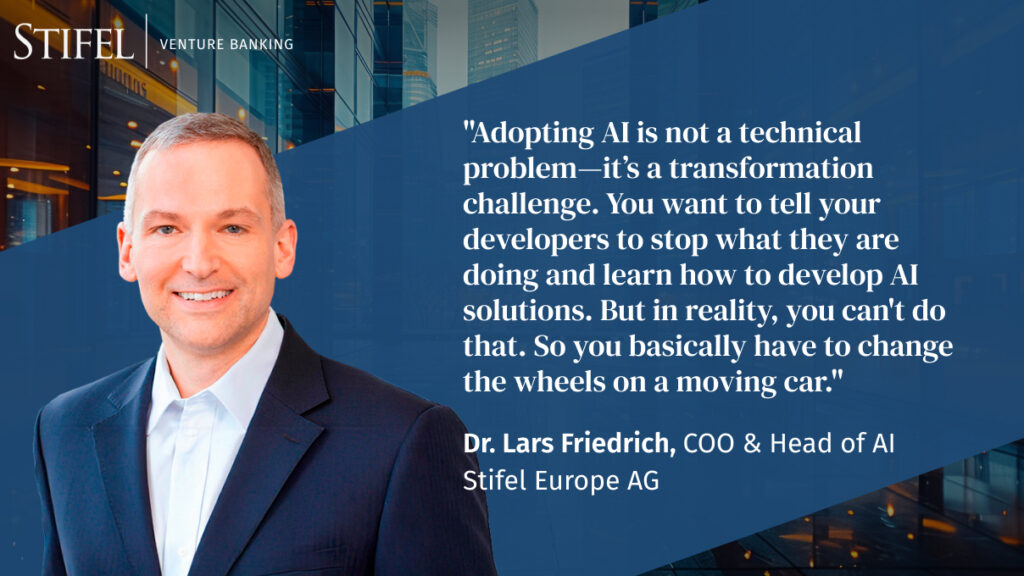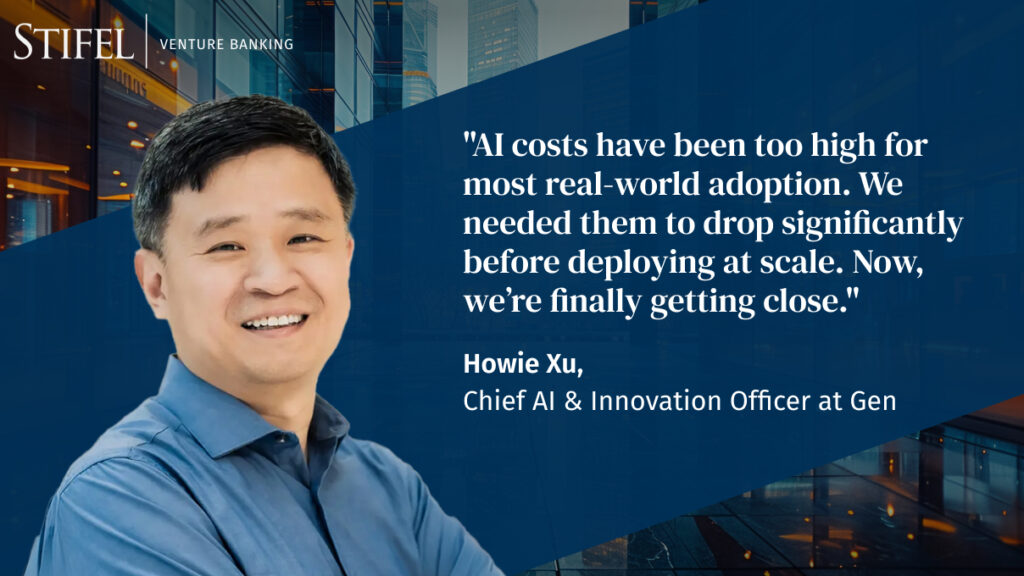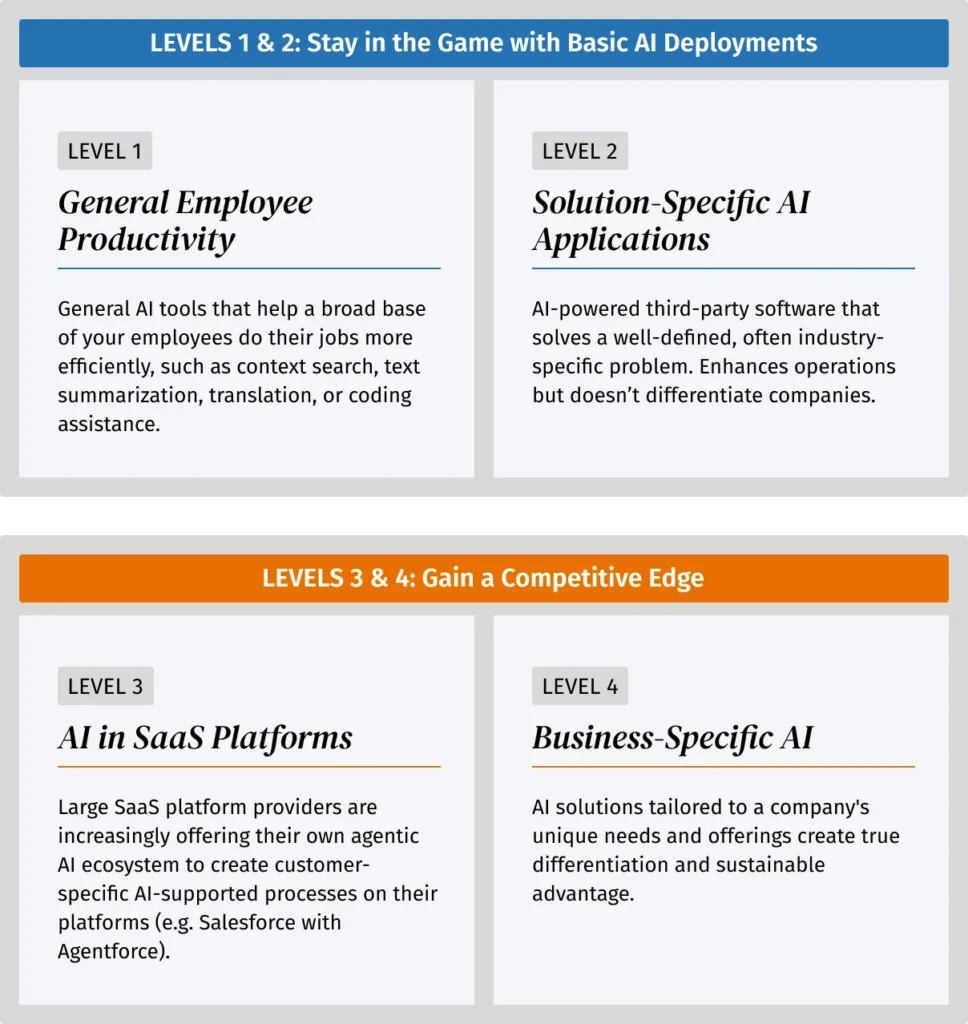A Founder’s Guide to the 2025 AI Landscape: Part One
Venture Banking

Beyond the initial buzz, the focus shifts to execution. Discover the trends in enterprise AI adoption in Part One of our AI deep dive.
The U.S. approach to AI is undergoing a dramatic shift. With President Trump’s “Removing Barriers to American Leadership in Artificial Intelligence” executive order, the administration is rolling back Biden-era oversight in favor of deregulation and private-sector-led innovation.
How can founders seize this window of opportunity and strategically position themselves for lasting success in an increasingly competitive AI market?
- Enterprises are doubling down on AI implementation, looking to gain a competitive advantage even as they face increased scrutiny to show results. Startups can help overwhelmed business leaders succeed.
- Venture capital is still flowing to generative AI and agentic AI—last year, one in three VC dollars globally went to AI, and AI-driven Series A have 40% higher valuations.
- The flipside? Fierce competition—with one in four startups now AI-related, differentiation is more critical than ever.
To learn more about what’s ahead, we spoke with Tomasz Tunguz, General Partner at Theory Ventures, Howie Xu, Chief AI & Innovation Officer at Gen, and Dr. Lars Friedrich, COO & Head of AI, Stifel Europe AG.
- Enterprise AI is a Change Management Challenge—Not Just a Tech One
- Enterprises Are Focusing on Attainable AI Goals
- What’s Accelerating Broader Enterprise Adoption?
- Is 2025 the Breakthrough Year for Enterprise AI?
Enterprise AI is a Change Management Challenge—Not Just a Tech One
AI has forced even the most traditional companies to move fast. Yet the reality of AI adoption has proven more difficult, cost-intensive, and uncertain in ROI than many expected. Xu notes that real-world enterprise AI use remains surprisingly low, as companies struggle to move beyond pilots.
That’s because AI adoption in enterprises isn’t just about technology—it’s about organizational transformation.
“Adopting AI is not a technical problem—it’s a transformation challenge. You want to tell your developers to stop what they are doing and learn how to develop AI solutions. But in reality, you can’t do that. So you basically have to change the wheels on a moving car.”
—Dr. Lars Friedrich, COO & Head of AI, Stifel Europe AG

Most enterprises operate on decades-old workflows, making AI adoption more of a fundamental transformation than a simple tech upgrade. As Tunguz explains, “The harder part of AI adoption is change management. AI is forcing people to completely rethink how they work.”
Here are some of the factors that make enterprises cautious about AI transformation:
- ROI isn’t yet proven: After a surge in 2023 AI spending, 2024 became a reckoning year for proving business value. Customer-facing AI (e.g., chatbots) is easier to justify, but AI-driven workflow automation has been slower to deliver measurable impact. “Many companies still don’t have an answer to that question,” says Xu.
- Tech improvements outpace enterprise adoption. AI evolves too fast for enterprises to confidently commit to any one model. As Friedrich notes, “If I choose Model X today, next week another provider releases Model Y, and it’s better. So, how do you make a choice?”
- Costs are just now coming down: AI deployment requires heavy investments in cloud infrastructure, engineering, and model training. Xu points out, “AI costs have been too high for most real-world adoption. We needed them to drop significantly before deploying at scale. Now, we’re finally getting close.”

- AI accuracy & trust concerns remain: Enterprises may perceive automation as risky because of AI hallucinations and errors—especially in regulated industries like finance and healthcare. Compliance and brand safety concerns further slow adoption.
Despite these hurdles, AI investment isn’t slowing down. As Tunguz notes, public markets reward AI innovation, with AI-powered software companies trading at twice the multiple of their non-AI peers. The incentive to keep evolving is clear—falling behind isn’t an option.
Enterprises Are Focusing on Attainable AI Goals
2025 is serving as a reckoning point for proving AI’s business value. Because overhauling workflows is complex, enterprises are prioritizing AI initiatives that offer immediate impact with minimal disruption. Their AI strategies remain incremental, prioritizing efficiency gains over full-scale transformation—at least for now.
- Customer-facing AI initiatives: AI-powered chatbots, personalized marketing, and search/recommendation engines are widely adopted in e-commerce, finance, and media. However, these are now table stakes, not differentiators. “Many companies thought AI would immediately transform customer experiences, but they underestimated the complexity of integration,” says Xu.
- Internal operational efficiency: AI is automating internal workflows, from document processing to CRM and sales forecasting. But successful adoption often requires restructuring processes, not just layering AI onto existing workflows.
- Industry-specific AI applications: High-stakes applications in healthcare (AI-assisted diagnostics), finance (risk management or sentiment analysis), and legal (contract analysis) are emerging, but strict accuracy and regulatory requirements slow adoption.
We interviewed Lars Friedrich, our own head of AI at Stifel, a 10,000-person, publicly traded company, to explain how Stifel approaches AI adoption and the level at which AI can truly offer enterprises a competitive advantage.
Stifel Insight: The 4 Levels of Enterprise AI Adoption
Levels 1 & 2: Stay in the Game with Basic AI Deployments
Level 1: General Employee Productivity
General AI tools that help a broad base of your employees do their jobs more efficiently, such as context search, text summarization, translation, or coding assistance.
Level 2: Solution-Specific AI Applications
AI-powered third-party software that solves a well-defined, often industry-specific problem. Enhances operations but doesn’t differentiate companies.
Levels 3 & 4: Gain a Competitive Edge
Large SaaS platform providers are increasingly offering their own agentic AI ecosystem to create customer-specific AI-supported processes on their platforms (e.g. Salesforce with Agentforce).
Level 4: Business-Specific AI
AI solutions tailored to a company’s unique needs and offerings create true differentiation and sustainable advantage.

What’s Accelerating Broader Enterprise Adoption?
Xu notes that AI adoption is less mature than he anticipated two years ago but sees 2025 as the wrong time to scale back investment. He believes it could be a potential breakthrough year, as costs fall and agentic AI capabilities emerge beyond LLMs.
A convergence of supply and demand is setting the stage for real acceleration in 2025 and beyond. Here are a few enterprise adoption trends we expect to drive that shift:
- Greater executive fluency in AI use cases: As decision-makers become more educated on how AI can impact finance, ops, HR, and customer experience, they’re growing more comfortable integrating dynamic AI tools into previously rigid workflows. The result? More top-down support, faster pilot approval, and broader enterprise readiness.
- Proven results creating momentum: Many enterprises are starting small—automating a single process, enhancing a niche workflow—and seeing success. That early traction often unlocks executive buy-in to expand the tool’s functional footprint. AI that starts in one department frequently finds its way across others once results are visible. It’s a classic “land-and-expand” motion, but AI-powered.
- AI as a force multiplier for smaller teams: While traditional data science remains foundational for many enterprise strategies—especially in highly regulated sectors—AI is opening new doors for smaller and mid-sized teams that can use AI to scale without hiring additional technical staff.
We’ve seen these trends firsthand. AI companies that start with targeted deployments and deliver measurable ROI are expanding naturally within enterprises. Adoption accelerates not through flashy pitches, but through proven success that builds internal momentum.
Is 2025 the Breakthrough Year for Enterprise AI?
As Xu notes, businesses face a “speeding ticket vs. parking ticket” dilemma: move too fast and risk investing in fleeting tech, move too slow, and risk falling behind AI-native competitors.
Despite the challenges, enterprises are poised to increase AI adoption in 2025. “For the first time, we’re talking about the ‘more real’ aspects of AI,” says Xu. Costs are falling. Agentic AI is enabling more practical, end-to-end workflows. And crucially, companies are starting to shift from pilots to deployment.
For founders, this is your moment. Enterprise buyers are looking for tangible solutions to help them unlock business value from AI. Help these buyers cut through the hype with a clear message of how your product can deliver value without triggering extensive change management, and you will find enterprises excited to partner with you to help them succeed in AI.
Written by
Related Insights
Other articles designed to help you along your financial journey.




